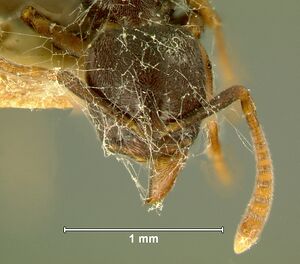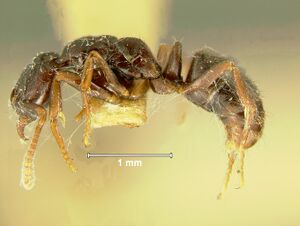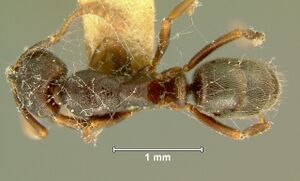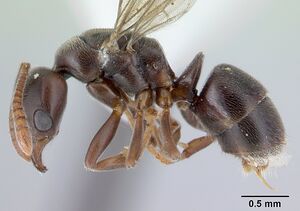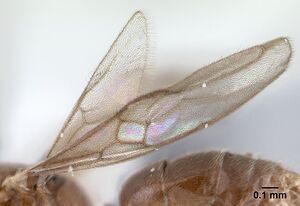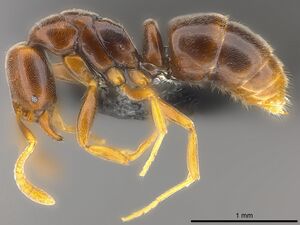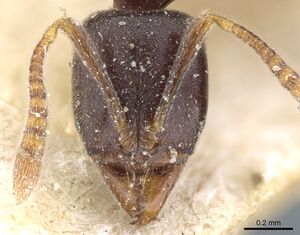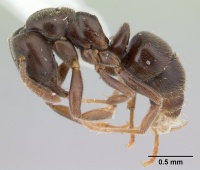AntWiki: The Ants --- Online
Identification
Keys including this Species
Distribution
Latitudinal Distribution Pattern
Latitudinal Range: 7.42° to -10.75°.
Indo-Australian Region: Micronesia (Federated States of), New Guinea (type locality), Northern Mariana Islands, Philippines, Solomon Islands.
Distribution based on AntMaps
Distribution based on AntWeb specimens
Check data from AntWeb
Countries Occupied
| Number of countries occupied by this species based on AntWiki Regional Taxon Lists. In general, fewer countries occupied indicates a narrower range, while more countries indicates a more widespread species.
|

|
Estimated Abundance
| Relative abundance based on number of AntMaps records per species (this species within the purple bar). Fewer records (to the left) indicates a less abundant/encountered species while more records (to the right) indicates more abundant/encountered species.
|

|
Biology
Castes
Nomenclature
The following information is derived from Barry Bolton's Online Catalogue of the Ants of the World.
- pruinosa. Ponera pruinosa Emery, 1900c: 319, pl. 8, figs. 13, 14 (w.) NEW GUINEA. Viehmeyer, 1916b: 284 (q.m.); Imai, Brown, et al. 1984: 67 (k.). Combination in Hypoponera: Imai, Brown et al. 1984: 67. Senior synonym of mocsaryi: Wilson, 1958d: 335. See also: Mann, 1919: 294.
Description
- n = 12, 2n = 24 (Indonesia; Malaysia; Sarawak) (Imai et al., 1983; Imai et al., 1985; Mariano et al., 2015).
References
- Baltazar, C.R. 1966. A catalogue of Philippine Hymenoptera (with a bibliography, 1758-1963). Pacific Insects Monographs 8: 1-488. (page 247, listed)
- Clouse, R. M. 2007. The Ants (Hymenoptera: Formicidae) of Micronesia. Micronesica. 39(2): 171–296.
- Dash, S.T. 2011. A taxonomic revision of the New World Hypoponera Santschi, 1938 (Hymenoptera: Formicidae). Ph.D. thesis, University of Texas, El Paso.
- Dash, S.T., Mackay, W.P. 2019. Capitulo 18. Genero Hypoponera. Hormigas de Colombia.
- Emery, C. 1900b. Formicidarum species novae vel minus cognitae in collectione Musaei Nationalis Hungarici quas in Nova-Guinea, colonia germanica, collegit L. Biró. Publicatio secunda. Természetr. Füz. 23: 310-338 (page 319, pl. 8, figs. 13, 14 worker described)
- Imai, H. T.; Brown, W. L., Jr.; Kubota, M.; Yong, H.-S.; Tho, Y. P. 1984. Chromosome observations on tropical ants from western Malaysia. II. Annu. Rep. Natl. Inst. Genet. Jpn. 34: 66-69 (page 67, Combination in Hypoponera)
- Imai, H. T.; Brown, W. L., Jr.; Kubota, M.; Yong, H.-S.; Tho, Y. P. 1984. Chromosome observations on tropical ants from western Malaysia. II. Annu. Rep. Natl. Inst. Genet. Jpn. 34: 66-69 (page 67, karyotype described)
- Mann, W. M. 1919. The ants of the British Solomon Islands. Bulletin of the Museum of Comparative Zoology 63: 273-391 (page 294, see also)
- Mariano, C.S.F., Santos, I.S., Silva, J.G., Costa, M.A., Pompolo, S.G. 2015. Citogenética e evolução do cariótipo em formigas poneromorfas. In: Delabie, J.H.C., Feitosa, R.M., Serrao, J.E., Mariano, C.S.F., Majer, J.D. (eds) As formigas poneromorfas do Brasil, 1st edn. Ilhéus, Brasil, pp 102–125 (doi:10.7476/9788574554419.0010).
- Viehmeyer, H. 1916b. Ameisen von den Philippinen und anderer Herkunft (Hym.). Entomol. Mitt. 5: 283-291 (page 284, queen, male described)
- Wilson, E. O. 1958g. Studies on the ant fauna of Melanesia III. Rhytidoponera in western Melanesia and the Moluccas. IV. The tribe Ponerini. Bulletin of the Museum of Comparative Zoology 119: 303-371 (page 335, Senior synonym of mocsaryi)
- CSIRO Collection
- Clouse R. M. 2007. The ants of Micronesia (Hymenoptera: Formicidae). Micronesica. 39: 171-295.
- Clouse, R.M. 2007. The ants of Micronesia (Hymenoptera: Formicidae), Micronesica 39(2): 171-295.
- Emery C. 1900. Formicidarum species novae vel minus cognitae in collectione Musaei Nationalis Hungarici quas in Nova-Guinea, colonia germanica, collegit L. Biró. Publicatio secunda. Természetrajzi Füzetek 23: 310-338.
- Emery C. 1911. Hymenoptera. Fam. Formicidae. Subfam. Ponerinae. Genera Insectorum 118: 1-125.
- Field Museum Collection, Chicago, Illinois (C. Moreau)
- Imai H. T., M. Kubota, W. L. Brown, Jr., M. Ihara, M. Tohari, and R. I. Pranata. 1985. Chromosome observations on tropical ants from Indonesia. Annu. Rep. Natl. Inst. Genet. Jpn. 35: 46-48.
- Janda M., G. D. Alpert, M. L. Borowiec, E. P. Economo, P. Klimes, E. Sarnat, and S. O. Shattuck. 2011. Cheklist of ants described and recorded from New Guinea and associated islands. Available on http://www.newguineants.org/. Accessed on 24th Feb. 2011.
- Le Breton J., J. Chazeau and H. Jourdan. 2002. Expression de Wasmannia dans une forêt dense humide et impact sur la myrmécofaune native de litière. P 57-63. In Etude de l'invasion de la Nouvelle-Calédonie par la fourmi pionnière Wasmannia auropunctata (Roger): modalités, impact sur la diversité et le fonctionnement des écosystèmes, moyens d'une maîtrise de la nuisance. Programme INWASCAL, Conventions Sciences de la Vie, Zoologie Appliquée 13.
- Le Breton J., J. Chazeau, and H. Jourdan. 2003. Immediate impacts of invasion by Wasmannia auropunctata (Hymenoptera: Formicidae) on native litter ant fauna in a New Caledonian rainforest. Austral Ecology 28: 204209.
- Lucky A., E. Sarnat, and L. Alonso. 2011. Ants of the Muller Range, Papua New Guinea, Chapter 10. In Richards, S. J. and Gamui, B. G. (editors). 2013. Rapid Biological Assessments of the Nakanai Mountains and the upper Strickland Basin: surveying the biodiversity of Papua New Guineas sublime karst environments. RAP Bulletin of Biological Assessment 60. Conservation International. Arlington, VA.
- Lucky A., K. Sagata, and E. Sarnat. 2011. Ants of the Nakanai Mountains, East New Britain Province, Papua New Guinea, Chapter 1. In Richards, S. J. and Gamui, B. G. (editors). 2013. Rapid Biological Assessments of the Nakanai Mountains and the upper Strickland Basin: surveying the biodiversity of Papua New Guineas sublime karst environments. RAP Bulletin of Biological Assessment 60. Conservation International. Arlington, VA.
- Lucky A., L. E. Alonso, E. Sarnat, and J. Hulr. 2015. Ants and scolytine beetles. In: Richards, S.J. and N. Whitmore (editors) 2015. A rapid biodiversity assessment of Papua New Guinea's Hindenburg Wall region. Wildlife Conservation Society Papua New Guinea Program. Goroka, PNG.
- Mann W. M. 1919. The ants of the British Solomon Islands. Bulletin of the Museum of Comparative Zoology 63:273-391.
- Mann William. 1916. The Ants of the British Solomon Islands. Bulletin of the Museum of Comparative Zoology at Harvard College 63(7): 273-391
- Mann, W.M. 1919. The ants of the British Solomon Islands. Bulletin of the Museum of Comparative Zoology of Harvard College 63: 273-391
- Room P. M. 1975. Diversity and organization of the ground foraging ant faunas of forest, grassland and tree crops in Papua Nez Guinea. Aust. J. Zool. 23: 71-89.
- Room, P.M. 1975. Relative Distributions of Ant Species in Cocoa Plantations in Papua New Guinea Relative Distributions of Ant Species in Cocoa Plantations in Papua New Guinea. Journal of Applied Ecology 12(1):47-61
- Snelling R. R. 1998. Insect Part 1: The social Hymenoptera. In Mack A. L. (Ed.) A Biological Assessment of the Lakekamu Basin, Papua New Guinea, RAP 9. 189 ppages
- Snelling R. R. 2000. Ants of the Wapoga river area, Irian Jaya, Indonesia. In Mack, Andrew L. and Leeanne E. Alonso (eds.). 2000. A Biological Assessment of the Wapoga River Area of Northwestern Irian Jaya, Indonesia. RAP Bulletin of Biological Assessment 14, Conservation International, Washington, DC.
- Szabó J. 1910. Uj hangya Uj-Guineából. Rovartani Lapok 17: 186.
- Taylor R. W. 1976. The ants of Rennell and Bellona Islands. Natural History of Rennell Island, British Solomon Islands 7: 73-90.
- Viehmeyer H. 1912. Ameisen aus Deutsch Neuguinea gesammelt von Dr. O. Schlaginhaufen. Nebst einem Verzeichnisse der papuanischen Arten. Abhandlungen und Berichte des Königlichen Zoologischen und Anthropologische-Ethnographischen Museums zu Dresden 14: 1-26.
- Wheeler W.M. 1935. Check list of the ants of Oceania. Occasional Papers of the Bernice Pauahi Bishop Museum 11(11):1-56.
- Wheeler, William Morton.1935.Checklist of the Ants of Oceania.Occasional Papers 11(11): 3-56
- Wilson E. O. 1958. Studies on the ant fauna of Melanesia III. Rhytidoponera in western Melanesia and the Moluccas. IV. The tribe Ponerini. Bulletin of the Museum of Comparative Zoology 119: 303-371.
- Wilson E. O. 1959. Some ecological characteristics of ants in New Guinea rain forests. Ecology 40: 437-447.
- Wilson Edward O. 1959. Adaptive Shift and Dispersal in a Tropical Ant Fauna. Evolution 13(1): 122-144



